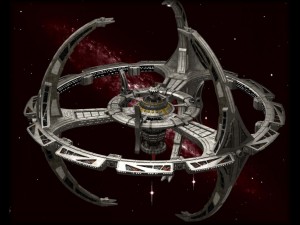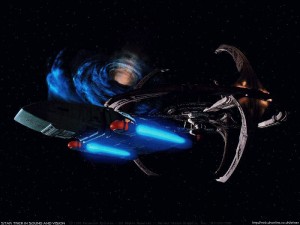 I love great storytelling. I mean, I LOVE great storytelling! I’m totally passionate about it. I seek it out constantly. I crave it, need it desperately. Really, I can’t get enough of it!
I love great storytelling. I mean, I LOVE great storytelling! I’m totally passionate about it. I seek it out constantly. I crave it, need it desperately. Really, I can’t get enough of it!
Great storytelling will expand your understanding of life and the universe. It can help you experience something you haven’t ever imagined before. It can flex your precious imagination with tremendous might. It can inspire you. It can make you laugh and/or cry. It can help fill your days with profound thoughts and feelings. It can carry you through the tough times and make a good day even better. It is something so special that you know it when you find it, and always remember it.
That’s why I love Star Trek: Deep Space Nine!
Honestly, I could write another daily blog with things about DS9. Instead, I’ll likely do occasional posts about the program and its influence on my life. (I may also do that about Batman as well, but that’s another string of stories for another time … like maybe tomorrow.)
For this entry, I’m going to give some background information on the show found at Wikipedia:
“Star Trek: Deep Space Nine (sometimes abbreviated to ST:DS9 or DS9) is a science-fiction television program that premiered in 1993 and ran for seven seasons, ending in 1999. Rooted in Gene Roddenberry’s Star Trek universe, it was created by Rick Berman and Michael Piller, at the request of Brandon Tartikoff, and produced by Paramount Television. The main writers, in addition to Berman and Piller, included show runner Ira Steven Behr, Robert Hewitt Wolfe, Ronald D. Moore, Peter Allan Fields, Bradley Thompson, David Weddle and Rene Echevarria.
“A spin-off from Star Trek: The Next Generation, DS9 began while its parent series was still on the air, and there were several crossover episodes between the two shows. In addition, two Next Generation characters, Miles O’Brien and Worf, became regular members of DS9.
 “Unlike the other Star Trek programs, DS9 took place on a space station instead of a starship, so as not to have two series with starships at the same time. (The starship U.S.S. Defiant was introduced in Season 3, but the station remained the primary setting for the show.) This made continuing story arcs and the appearance of recurring characters much more feasible. The show is noted for its well-developed characters and its original, complex plots. The series also depended on darker themes, less physical exploration of space, and an emphasis (in later seasons) on many aspects of war.
“Unlike the other Star Trek programs, DS9 took place on a space station instead of a starship, so as not to have two series with starships at the same time. (The starship U.S.S. Defiant was introduced in Season 3, but the station remained the primary setting for the show.) This made continuing story arcs and the appearance of recurring characters much more feasible. The show is noted for its well-developed characters and its original, complex plots. The series also depended on darker themes, less physical exploration of space, and an emphasis (in later seasons) on many aspects of war.
“Although DS9‘s ratings were solid, it was never as successful as the syndicated Star Trek: The Next Generation, with approximately 6% versus 11% of U.S. households watching during sweeps months. However it performed better than its network sibling Star Trek: Voyager which averaged around 5% according to the Nielsen ratings. One factor was the increasingly crowded syndicated marketplace which provided viewers with a number of alternative shows to follow. Another factor was the minimal promotion for DS9, as Paramount focused its efforts on its flagship network show Star Trek: Voyager. Finally, from 1995 onwards, most of the independent stations joined new networks (UPN and The WB), and these primetime shows gradually pushed DS9 into weekend/late-night slots when few viewers were watching. The U.S. television market expanded from four networks (1987 when TNG premiered) to six. The competition became so intense that eventually DS9‘s ratings dropped below fantasy fiction rivals Hercules: The Legendary Journeys and Xena: Warrior Princess, and by the year 2001 nearly all original programming for syndication had disappeared.”
I’ll continue this discussion another time, but suffice it to say that this show changed my life forever, including eventually leading me to SciFiPulse.Net. More on that later!
For today’s video, I thought we’d watch and listen to the title sequence for most of DS9‘s time on the air, the last four seasons:
